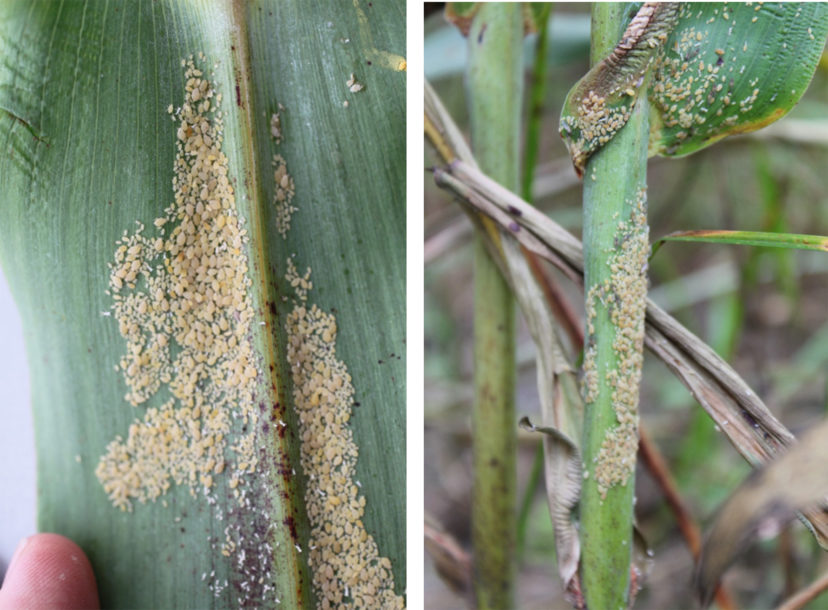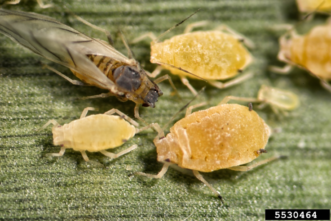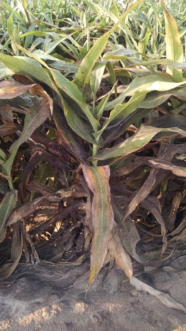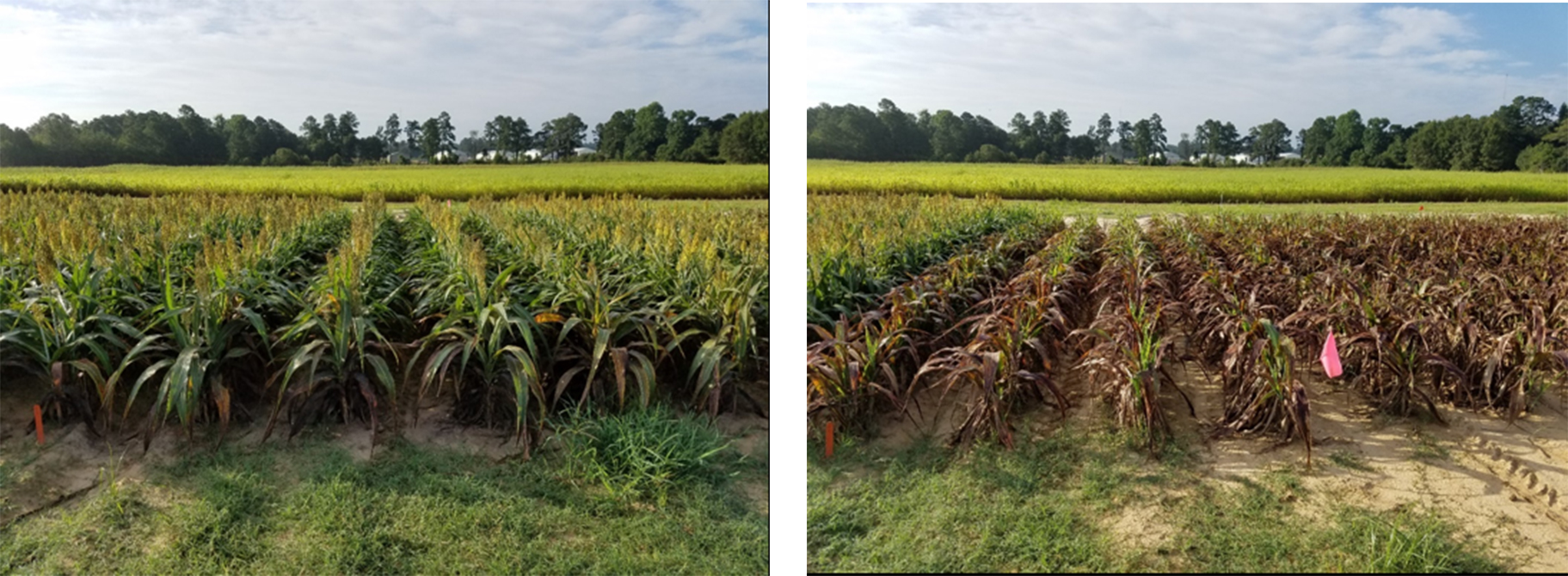Introduction
The invasive sugarcane aphid (Melanaphis sacchari, SCA) was first detected in the continental United States on sugarcane in Florida in 1977 and in Louisiana in 1999. The insect was not considered a pest of sorghum until 2013 when it was found in large numbers on grain and forage sorghum in Texas. This new strain or biotype was also found in Mississippi, Louisiana, and Oklahoma in 2013; it rapidly spread in 2014 to Arkansas, Tennessee, Alabama, Georgia, and South Carolina; and continued to spread in following years to other sorghum states.1 In South Carolina, the insect was found for the first time in sorghum in October 2014 (figure 1).1 The outbreaks on sorghum are caused by a new invasive genotype, likely originating from Africa or Asia.2 It is currently unknown if the SCA can successfully overwinter in South Carolina. However, the insect is able to successfully infest sorghum fields in South Carolina, with first infestations generally occurring from late-May to mid-June.

Figure 1. Sugarcane aphids on grain sorghum (South Carolina, October 2014). Photo credit: Francis P. F. Reay-Jones, PhD, Clemson University.
Identification

Figure 2. Non-winged and winged adults and nymph sugarcane aphids. Photo credit: Patrick Porter, Texas Cooperative Extension, Bugwood.org.
The color of SCA can range from grey to pale yellow (figure 2). The dark cornicles (tail pipes) and dark tarsi (feet) differentiate this species from the other aphid species in sorghum, in addition to the SCA generally being the only species present in high numbers on sorghum.1 Three minor aphid pest species can be found on sorghum in South Carolina. Greenbugs (Schizaphis graminum) have a characteristic dark stripe along the back. Yellow sugarcane aphids (Sipha flava) are covered with spines and have shorter cornicles and generally a brighter yellow color compared to SCA. Corn leaf aphids (Rhopalosiphum maidis) can be identified by their blue-grey color.
Life Cycle

Figure 3. Heavily infested sorghum plant with sooty mold visible on lower leaves (Florence, South Carolina, 2015). Photo credit: Francis P. F. Reay-Jones, PhD, Clemson University.
All SCAs are female that reproduce asexually in the United States,1 though production of eggs has been reported from Mexico.3 They give birth to live wingless immature females (nymphs), which become adults within four to twelve days.4 Adults can be either winged or wingless (figure 2) and can live for ten to thirty-seven days.5 The severity of the pest status on sorghum is related in part to the reproductive potential of the insect, as growth rates can be exponential, with over 8,000 aphids observed on a single sorghum leaf in a trial in South Carolina. Adults and nymphs are thought to need a live host plant to survive the winter, with annual movement occurring from more southern locations in the United States. Since 2015, SCA has been found on Johnsongrass in South Carolina in early June before moving into sorghum.
Injury to Sorghum
The SCA can cause significant economic damage to sorghum by feeding on plant sap, generally on the underside of leaves and on the stalk (figure 1), which can seriously injure or kill plants.1 Aphids secrete a sticky substance called honeydew as they feed, which can cover plants. A sooty mold (fungus) then accumulates on the honeydew, leading to a decrease in photosynthetic activity (figure 3). Feeding by SCA can lead to necrosis of leaves and reductions in yield under heavy pressure, including complete crop failure observed in research plots when infestations begin prior to boot stage in sorghum (figure 4).

Figure 4. Heavily infested sorghum plot (right) and partially protected sorghum plot (left), Florence, South Carolina, 2016. Photo credit: Francis P. F. Reay-Jones, PhD, Clemson University.
Management
Insecticides and Economic Thresholds
Insecticides are often needed for SCA control. Pyrethroid insecticides should not be used when SCAs are present, as these insecticides will flare populations of SCA by reducing numbers of natural enemies. The insecticides Sivanto Prime (flupyradifurone) and Transform (sulfoxaflor) provide good control of SCA on grain sorghum. Neonicotinoid insecticide seed treatments can also reduce infestations, though the decision to use a seed treatment will only pay off when infestations begin early in the season. Because seed treatments only have activity for the first few weeks after planting, they may not always be needed since SCA pressure can peak later in the growing season beyond this window where seed treatments are effective. Management in forage sorghum can be more challenging because of the size of the canopy that limits contact between the insect and the insecticide.
As SCA populations can build rapidly, sorghum fields need to be scouted once or twice a week. An economic threshold of fifty aphids per grain sorghum leaf was determined based on field trials in South Carolina and in the southern United States.6 All fields should be scouted, regardless of hybrid planted. Modifications to thresholds should be considered based on management costs and price of sorghum. Even tolerant hybrids will need an application under moderate to heavy pressure.
Biological Control
Management of SCA in grain sorghum can involve several control tactics. A range of natural enemies have been shown to help in reducing populations, including several lady beetle species, green lacewings, hoverflies, an Aphelinus parasitoid, and an entomopathogenic fungus.1, 7 However, natural enemies often do not provide sufficient levels of control under heavy SCA pressure.
Host Plant Resistance
Selection of a sorghum hybrid with tolerance to SCA is a key decision. Several grain and forage sorghum hybrids have levels of tolerance to SCA feeding relative to susceptible standard hybrids.8, 9 An important consideration is that the value of using tolerant hybrids will only be apparent under moderate to heavy aphid pressure. Yield potential should be a primary factor when choosing hybrids. A good resource to help choose a hybrid with good yield is the Clemson University Grain Sorghum Variety Test Data. Trials in South Carolina underline the value of selecting tolerant hybrids; although complete control is not achieved under moderate to heavy pressure, these tolerant hybrids can help to delay the need for the first application of insecticide. Under moderate to low pressure, yield loss can be prevented by selecting a tolerant hybrid.
Summary
SCA has rapidly become a key insect pest of sorghum in the United States since its introduction in 2013. Management can be achieved by using a combination of tolerant hybrids and insecticides, in addition to allowing the numerous natural enemies help regulate populations.
References Cited
- Bowling RD, Brewer MJ, Kerns DL, Gordy J, Seiter N, Elliott NE, Buntin GD, Way MO, Royer TA, Biles S, Maxson E. Sugarcane aphid (Hemiptera: Aphididae): a new pest on sorghum in North America. Journal of Integrated Pest Management. 2016;7(1):12. doi:10.1093/jipm/pmw011.
- Nibouche S, Costet L, Holt JR, Jacobson A, Pekarcik A, Sadeyen J, Armstrong JS, Peterson GC, McLaren N, Medina RF. Invasion of sorghum in the Americas by a new sugarcane aphid (Melanaphis sacchari) superclone. PLoS ONE. 2018;13(4): doi:10.1371/journal.pone.0196124.
- Pena-Martinez R, Muñoz-Viveros AL, Bujanos-Muñiz R, Luevano-Borroel J, Tamayo-Mejia F, Cotez-Mondaca E. Sexual forms of sorghum aphid complex Melanaphis sacchari/sorghi in Mexico. Southwestern Entomologist 2016;41(1):127–131.
- Chang CP, Fang MN, Tseng HY. Studies on the life history and varietal resistance in grain sorghum aphid, Melanaphis sacchari Zehntner in central Taiwan. Chinese Journal of Entomology. 1982;2:70–81.
- Singh BU, Padmaja PG, Seetarama N. Biology and management of the sugarcane aphid, Melanaphis sacchari Zehntner (Homoptera: Aphididae), in sorghum: a review. Crop Protection. 2004;23(9):237–255.
- Gordy, JW, Brewer MJ, Bowling RD, Buntin GD, Seiter NJ, Kerns DL, Reay-Jones FPF, Way MO. Development of economic thresholds for sugarcane aphid (Hemiptera: Aphididae) in susceptible grain sorghum hybrids. Journal of Economic Entomology. 2019;112(3):1251–1259.
- Haar PJ, Bowling R, Gardner WA, Buntin GD. Epizootics of the entomopathogenic fungus Lecanicillium lecani (Hypocreales: Clavicipitaceae) in sugarcane aphid (Hemiptera: Aphididae) populations infesting grain sorghum in Georgia and Texas. Journal of Entomological Science. 2018;53(1)104–106.
- Paudyal S, Armstrong JS, Giles KL, Payton ME, Opit GP, Limaje A. Categories of resistance to sugarcane aphid (Hemiptera: Aphididae) among sorghum genotypes. Journal of Economic Entomology. 2019;112(4):1932–1940.
- Lahiri S, Ni X, Buntin GD, Punnuri S, Jacobson A, Reay-Jones FPF, Toews MD. Combining host plant resistance and foliar insecticide application to manage Melanaphis sacchari (Hemiptera: Aphididae) in grain sorghum. International Journal of Pest Management. 2019. doi:10.1080/09670874.2019.1660830.
Technical Contribution No. 6833 of the Clemson University Experiment Station. This material is based upon work supported by NIFA/USDA, under project number SC-1700532.

